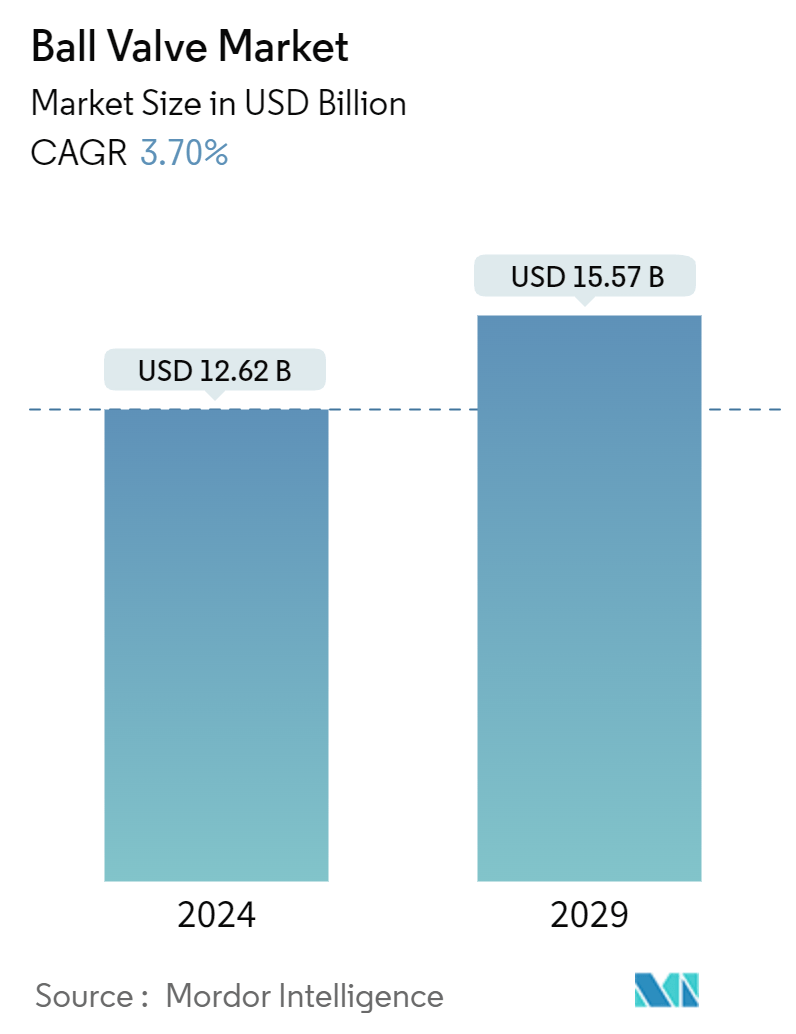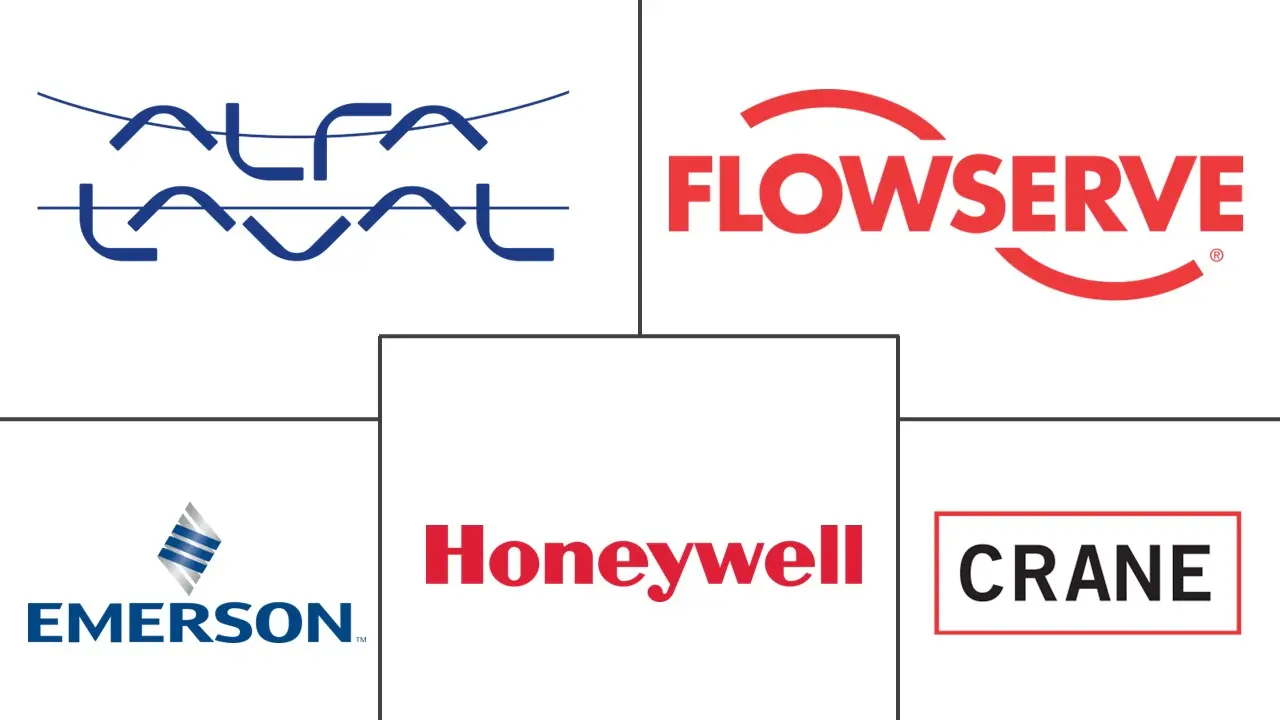Market Size of Ball Valve Industry

| Study Period | 2019 - 2029 |
| Market Size (2024) | USD 12.62 Billion |
| Market Size (2029) | USD 15.57 Billion |
| CAGR (2024 - 2029) | 3.70 % |
| Fastest Growing Market | Asia Pacific |
| Largest Market | Asia Pacific |
Major Players
*Disclaimer: Major Players sorted in no particular order |
Ball Valve Market Analysis
The Ball Valve Market size is estimated at USD 12.62 billion in 2024, and is expected to reach USD 15.57 billion by 2029, growing at a CAGR of 3.70% during the forecast period (2024-2029).
A significant rise in the demand for oil and gas is expected to be one of the significant factors contributing to the ball valve market growth. Additionally, rapid industrialization and urbanization are other essential factors supporting the development of the studied market.
- The ball valve is essentially a valve that requires a quarter-turn to operate and is well-suited for clean gas-compressed air and liquid service in industrial applications, owing to its ability to provide a secure shutoff. However, when used for slurry service, measures must be taken to prevent the accumulation of debris. Furthermore, these valves are incredibly robust and highly suitable for applications requiring a simple on/off action. They're also highly durable and maintain consistent performance even after many use cycles.
- Ball valves are the most widely adopted fluid shutoff valves among oil and gas production facilities. These valves are also used in fuel gas systems feeding furnaces. Such applications make the oil-producing regions and regions with huge oil refining capacities attractive targets for the product vendors. Furthermore, as such plants are developed on tender floatation, the market vendors with partnerships and collaborations with such solution providers are expected to have a competitive advantage.
- Among all the types of materials, stainless steel is gaining and is expected to witness importance since they are more corrosion-resistant. Because valves open and close frequently, corrosion can cause significant issues. These valves hold up much better to harsher water types, which can benefit food processing plants. The fact that stainless steel valves also have a higher pressure rating than other materials, such as brass, further drives their adoption.
- Furthermore, the availability of ball valves in different variants, such as unidirectional, bidirectional, or multi-directional, depending on valve ports and the valve seat number, also complements their industrial adoption. These valves are also manufactured based on the classification for high-pressure or low-pressure pipelines, further expanding their use cases. Several vendors are constantly investing in innovative new products, which is acting as one of the major factors driving the market.
- The advancements in valve technology, including the emergence of smart valves and the incorporation of automation and control systems, present fresh prospects in the market. The rising environmental concerns and regulatory mandates fuel the need for eco-friendly and energy-efficient valves. Manufacturers who provide ball valves with minimized emissions, low leakage rates, and enhanced energy efficiency can seize the expanding demand for sustainable solutions.
- Ball valves are commonly employed in larger bore sizes, as alternative valve types like butterfly valves tend to have smaller and weaker stems. In situations where space constraints and structural load are paramount, such as offshore drilling platforms and floating production storage and offloading (FPSOs), users opt for alternatives to ball valves. Furthermore, the limited precision in flow rate control poses a challenge to the growth of the examined market.
Ball Valve Industry Segmentation
The ball valve is a spherical closure device that controls the flow and pressure of liquids and gases within a system. These quarter-turn valves use a hollow, perforated, and pivoting ball to control flow through it.
The ball valve market is segmented by material (cast iron, steel, alloy-based), end-user industry (oil and gas, chemicals, water and wastewater, power, food and beverage, pharmaceuticals), and geography (North America, Europe, Asia Pacific, Latin America, and the Middle East and Africa).
The market sizes and predictions are provided in terms of value in USD for all the above segments.
| By Material (Qualitative Analysis) | |
| Cast Iron | |
| Steel | |
| Alloy Based | |
| Other Materials |
| By End-User Industry | |
| Oil and Gas | |
| Chemicals | |
| Water and Waste Water | |
| Power | |
| Food and Beverage | |
| Pharmaceutical | |
| Other End-User Industries |
| By Geography*** | |
| North America | |
| Europe | |
| Asia | |
| Australia and New Zealand | |
| Latin America | |
| Middle East and Africa |
Ball Valve Market Size Summary
The ball valve market is poised for steady growth over the forecast period, driven by increasing demand in the oil and gas sector, rapid industrialization, and urbanization. Ball valves, known for their robust and durable nature, are widely used in industrial applications requiring secure shutoff and simple on/off actions. Their adoption is further bolstered by the growing need for corrosion-resistant materials like stainless steel, which offers higher pressure ratings and better performance in harsh environments. The market is characterized by a diverse range of valve variants and materials, catering to various industrial needs, including high-pressure and low-pressure applications. The introduction of smart valves and automation technologies is expected to open new avenues, aligning with the rising demand for eco-friendly and energy-efficient solutions.
North America emerges as a significant market for ball valves, with substantial demand across industries such as oil and gas, electricity, and food processing. The region's focus on industrial automation and intelligent valve systems is driving market expansion. The United States, in particular, sees heightened demand due to its energy consumption and ongoing projects in oil extraction and water infrastructure. The fragmented nature of the market, with numerous players engaging in mergers and acquisitions, highlights its lucrative potential. Key industry players are continuously innovating and expanding their product portfolios to meet the diverse needs of the market, ensuring a competitive landscape.
Ball Valve Market Size - Table of Contents
-
1. MARKET INSIGHTS
-
1.1 Market Overview
-
1.2 Industry Attractiveness - Porter's Five Forces Analysis
-
1.2.1 Bargaining Power of Suppliers
-
1.2.2 Bargaining Power of Consumers
-
1.2.3 Threat of New Entrants
-
1.2.4 Threat of Substitutes
-
1.2.5 Intensity of Competitive Rivalry
-
-
1.3 Industry Value Chain Analysis
-
1.4 Impact of COVID-19 on the Market
-
-
2. MARKET SEGMENTATION
-
2.1 By Material (Qualitative Analysis)
-
2.1.1 Cast Iron
-
2.1.2 Steel
-
2.1.3 Alloy Based
-
2.1.4 Other Materials
-
-
2.2 By End-User Industry
-
2.2.1 Oil and Gas
-
2.2.2 Chemicals
-
2.2.3 Water and Waste Water
-
2.2.4 Power
-
2.2.5 Food and Beverage
-
2.2.6 Pharmaceutical
-
2.2.7 Other End-User Industries
-
-
2.3 By Geography***
-
2.3.1 North America
-
2.3.2 Europe
-
2.3.3 Asia
-
2.3.4 Australia and New Zealand
-
2.3.5 Latin America
-
2.3.6 Middle East and Africa
-
-
Ball Valve Market Size FAQs
How big is the Ball Valve Market?
The Ball Valve Market size is expected to reach USD 12.62 billion in 2024 and grow at a CAGR of 3.70% to reach USD 15.57 billion by 2029.
What is the current Ball Valve Market size?
In 2024, the Ball Valve Market size is expected to reach USD 12.62 billion.

